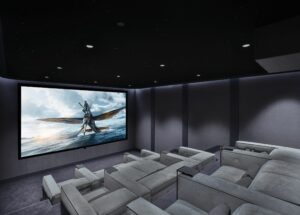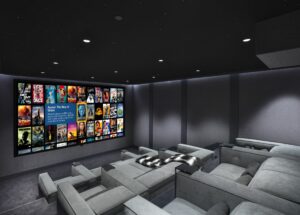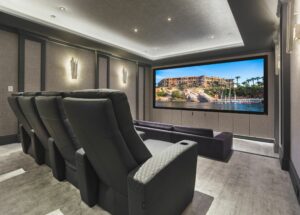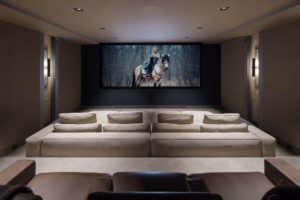The Technical Artistry of Film – Sight, Sound, Score and More
Artistry is in the eye of the beholder. Van Gogh isn’t for everyone. Interpretive dance might be a bit too far out for another. No one can deny an individual’s determination of beauty based on their personal perspective. Art must be viewed with an open hand. What does the artist have to say? How does this piece impact our emotions? Does it inspire? As the 7th art, Film is no different. When motion pictures were introduced, people were first drawn to the novelty. Today’s discerning viewer discovers transcendence. Technology pushes the envelope bringing locale, era and emotion, perceived or real, through our eyes and ears and into our hearts and minds. Our art has matured.
Cinema, the 7th Art
Norma Garcia-Muro, Vice President of Marketing at Kaleidescape, previously a Paramount Pictures and Lucasfilm alum, spoke about a film she recently viewed and its impact on her. “It moved me profoundly to the point that I couldn’t sleep. I just kept replaying it,” shares Norma. UK film The Stupid Boy uses silence, emotions, poignant cinematography and music in concert with an absence of words to create a milieu. The audience is introduced to a boy with special needs, tormented by bullies in high school. Maintaining a loving heart, he runs up to everyone he meets and greets them with a huge midsection hug. “He had this endearing, very loving affect,” said Norma. In a parallel story, envision a man, hopeless with a lifetime of hurt and injustice, a bomb strapped around his torso. Norma narrates as their stories converge in a farmer’s market, “That kid looked at him with empathetic eyes, walked up to him, and the guy’s like, ‘Don’t come up to me, I’m gonna ignite it.’“ Yet the boy looks at the man with empathetic eyes and gives him a hug. Right around the middle, right around that bomb. “The hug, the embrace was so touching and long,” said Norma.
As the story continues, the man doesn’t know what to do with this boy wrapped around him and the device he had intended to cause harm. And then the movie slows. “Because the scene slowed down, not slow motion, but focused so you could see the emotion on their faces, hear the music in the background, it just worked you up more,” shares Norma. The long scene allows opportunity for the audience to empathize with this potential killer and his struggles. “It was the editing, the sound and how the scene played out, because the pacing was just long enough,” Norma relates. “Some long shots, some closeups. It felt like you were there. Everybody was crying.” In the end, this intended killer breaks down and begins to cry with this innocent young man holding him up. “You could see, almost touch, these connections,” said Norma. “Then the kid says, ‘It’s okay, just let it go.’“
“That’s the artistry of the film writer who created this moment and all of those pieces that came together. Artisans in the background who orchestrated the music, cinematography, everything to tell that story in such an eloquent way that was beyond what words could do,” believes Norma. “Consider how many pages would be necessary to write that scene? How many people are required to finish it?” Contemplate the number of people essential, yet often unseen, needed to create a movie. Run the credits! Celebrate the artists, each one adding a brush stroke to the finished production. A work of art.
An Art Collective
Storytelling has a rich history in humanity, and the art of film carries the banner forward. “Audiences don’t know the magnitude of the village that is in the background to create one simple scene,” shared Norma. “Long painstaking hours behind the theater curtain wondering, ‘Are they going to cry and laugh? Are we creating that moment of suspense? Are we carrying them?’ It’s the emotions that we look for. And that is the payoff for all creative people in creating the story.” Filmmakers. Storytellers.
Innumerable special talents come together to create movie magic. Screenwriter, sound designer, sound editor, cinematographer, score composer, film editor, and many more make up the veritable village of artists that Norma references. Each one skilled, trained and impassioned for the pursuit of perfection in sight, sound and story for our entertainment. And yet, it’s so much more. “Cinematography is a whole dimension of the artistry of film,” said Norma, “and I think there are a lot of parallels that occur with how we receive a visual image and what that does to us emotionally as one part of our experience alongside what the sound does to us. Then the combination of those with the score, the writing, all to bring about a complete emotional response to the story. Artists working together to evoke this emotion.”
Sound artists, sound designers, sound editors, et al, are storytellers synthesizing the sonic language, the soundscape of a scene. Sound designer and Oscar winner, Mark Mangini sets the stage, “A simple example would be a medium [distance] shot of a person, and you don’t know where they are. You can speak volumes about their circumstances by the atmospheric sounds that surround them. You could have a lively ambiance like birds and bugs, which indicates some kind of life in their environment. You could pull that out and hear sirens and traffic to indicate something urban or maybe a dangerous environment. It’s all little auditory cues constantly telling a part of the story to the audience without them being aware of it. This is where the true masters of sound are the most effective.” Exudes Mark, “I’m gonna make movies sing with sound!”
In a sense, through organized sound, the editor is composing music. “We leverage these ideas in so many different ways. One way is subtraction, not addition,” shares Mark. “There’s a lovely scene in the first Dune film where Paul is learning to use the voice and as he’s attempting to develop the skill, we actually start to remove all the sounds to create what we call selective focus. We want the audience to only hear specific sounds. It’s a very unreal environment as if to summon the skill you have the ability to defy the laws of physics. And so, we rob the audience of sound, and that creates a claustrophobic feel as if you’re inside of Paul’s head.”
Music was a common thread woven into a conversation with film editor Jeffrey Ford “Music is a great analogy for filmmaking,” said Jeff. “They’re very similar.” People often ask him about the process of making a movie from beginning to end and the emotions involved. He compares film editing to the creative process involved in developing an album. Citing the Disney Beatles documentary by Peter Jackson, he points out, “That’s one of the best examples of a creative process and what the process feels like.” Clarifying, he reveals, “It’s about discovery, it’s about accidents, it’s about happenstance, it’s about conflict, it’s about resolution. You see the struggle where at one moment they don’t know what they’re going to do. It didn’t happen; it didn’t work.” Reflecting on the artistic mystery of it all, he concludes, “Four seconds later it worked, and you don’t know what changed, right? Something came to you, an idea or a combination of things happened. That’s what I think draws us to doing this work so much.”
“Unlike anyone else, I see the movie from script stage to completion,” says Jeff. “Cinematographers are involved during production and come back for color correction, but I’m on the whole time,” and 50% of his job as a picture editor is editing the sound. Speaking to the concert of dialogue, sound effects and music, Jeff believes, “Those things are all storytelling tools that I use. Editing is writing.” He continues, “All those rhythms are connected to each other. It’s very much like writing the movie after it’s been shot.” Jeff shares that the story evolves during edits. “Discoveries happen often. I can’t tell you how many times we’ve been sitting in an editing room thinking, ‘This movie is not going to work. There’s no way. We don’t know what to do. It’s just not going to be any good.’ And five minutes later you’re like, ‘This is the best movie I’ve ever seen,’ because you just had an idea that changes the whole context of the film. Now the audience will be able to see what you’re trying to do. That is what’s addictive about filmmaking for a lot of us. The creative discoveries that you make. That’s why we all come back to do it.”
Unity, an important tenet in any artform, is necessary in moviemaking. Consider a film editor’s requisite interaction with the sound editor as pieces are cut and reassembled, working side by side and feeding off the energy of each other’s expertise. These behind the scenes aspects of film production that grab an audience’s heartstrings and bury their emotions into the story line, often aren’t given the respect they deserve. Sharing his dismay at the underappreciated status of sound work, Mark describes sound as “an extraordinarily efficient narrative tool. But the non-obvious form of what we do is a kind of storytelling. The narrative contributions we make to movies in ways that audiences aren’t, and probably shouldn’t be, aware of because we can lead them with sound without having to use words to say the same thing.”
Yet, these artists are not recognized with the more prominent crafts like acting, directing or hair, makeup, and casting. “We have to fight every film for that additional recognition,” says Mark. “And it pains me.” Some progressive filmmakers literally put their money where their mouth is and support this collaboration. “George Lucas. Denny Villano, George Miller. Chris Nolan,” shares Mark. “They start sound early in the process, sometimes as early as the script phase. They have sound design during production. They have VFX and sound working together, symbiotically and collaboratively. And look at what you get! A cinema experience that overwhelms an audience. But that’s not the norm.” Considering the caliber of filmmakers who include sound editors from the beginning, you begin to wonder why more are not following their lead?
Perhaps there is hope on the horizon. The Academy community has added a new Production and Technology Branch to their awards list, recognizing 400 individuals previously classified as members-at-large. Coming 10 years after the creation of the Casting Directors, This new branch represents artists who work in key technical and production positions throughout all phases of filmmaking with the purpose of ensuring new voices and professions are represented. Mark recognizes this as a positive direction sharing, “It just means that we’re bringing more qualified, intelligent filmmakers into the fold to be a part of the Academy community. I think this branch opening up just makes us a stronger group that way.”
Audience Authority
Producers and studios will listen. If the audience is willing to accept a small story on a small screen, then that is exactly what they will get. Audience determines the state of our art, and demand will drive quality. Norma offers, “I would just wonder, if our audience was aware of the work involved, how much more enjoyment would they get out of their experience?” Making a comparison to wine tasting, taking a sip and enjoying the flavors, Norma relates that the sommelier “calls out the different fruits or the flavors, and you’re like, ‘Well, I didn’t get that, but let me pour another glass.’” Knowledge enhances appreciation by understanding the story of that particular vintage. “You could change biases with those feelings,” believes Norma. ”It is powerful, right? Film and storytelling are powerful, and there are so many components.”
Audience is an element that film artists consider as part of a story’s tapestry. Jeff determines, “It’s my responsibility to be them (the audience) while I’m cutting” and contemplates the film through viewer spectacles while making edits ensuring the intended message is conveyed. “They don’t have all of the information I have,” he says. “They haven’t read the screenplay. They haven’t been staring at it for 16 hours a day, six days a week for a year.” Since moviegoers don’t have the background information when watching a film, Jeff must consider, “What does the audience need to know to understand this story? So I’m both storyteller and audience.”
Staying true to the integrity of storytelling, Jeff shares that sometimes his job is to make the audience uncomfortable, unsettled. “A story has things that you cannot change about it. So, deciding what story you’re telling and honoring that is the process of looking out for the audience.” He continues, “They want to be challenged with new information telling them something about the world.” Jeff asserts, “Films are great because you can experience things that you didn’t in your life, but still have the feeling of what it was like to try that emotion or adventure on without any risk other than your emotional risk.” We go to the movies to feel something!
Artists want to tell us something, make us feel a certain way, to feel the full impact of their creations, so presentation is incredibly important. When Claude Monet decided to donate eight panels of Nymphéas (Water Lilies) to the Musée de l’Orangerie in Paris, he was very specific and worked closely with the architect, Camille Lefévre, in planning the forms, volumes, positioning, rhythm and spaces between panels according to the museum’s website. Monet designed the space to make the paintings resonate according to the weather by the changing viewing experience whether surveyed on a sunny day with light streaming in from above to flood the space or muted when the sun was masked by clouds. Art in motion. And just like beloved paintings, film experience will differ depending upon how it’s viewed.
“There are levels of immersion associated with a piece of cinema or music that change depending on how you hear or see it,” relates Jeff. “If you see a film on a large format screen like IMAX or a Dolby Cinema with ATMOS and in an acoustically controlled auditorium presented the way it was intended, it lets you transcend from where you are and enter that world fully, without distraction.” He continues, “It pulls you in, and your senses are completely dominated by that world. It affects your senses in a way that you can’t possibly compare to watching on an iPhone with AirPods or at home from a smaller speaker, because it’s bigger than you both visually and auditorily. It’s just gonna blow your mind!”
Living Art Gallery: Private Cinema
“What is fascinating about home cinema is that it is indeed the lasting legacy of current cinema,” says Mark. “Which is to say, a film will open and premiere in a hundred, a thousand, 4,000 theaters worldwide. It will have its run, if it’s good, maybe four or five or six weeks, maybe longer.” He asserts, “Cinema has a life in the home theater with a very, very long tail, which is why it’s so valuable to the studios and audiences.” Luxury private cinemas exceptionally apportioned with properly balanced equipment allows home viewers to experience film as intended by the movie’s creators. Mark concludes, “What’s particularly interesting is that if you have a good sound system in your home it’s your opportunity to hear the film exactly the way the filmmakers intended. It’s vital to us for you to see and hear an experience of film the way we did when we made it.”
Jeff wants viewers to understand the importance of viewing movies according to the artists’ intent. “When you hear it right and see it right, it is a different experience.” Sound and image artists want to have complete control of the sound levels, the image brightness, the quality of the sound and image. If the viewing environment changes, everything changes. “That’s not what the filmmakers made,” he states. “But if you want the full experience, you have to completely give yourself over to it.” Mark agrees with Jeff stating, “There is a reason why some artists don’t focus on certain things. Something could seem out of focus, and you don’t get to see that on a small screen.” Oftentimes, film editors will adjust the intensities of certain colors of an image, or you wonder why the camera is focusing on that specific detail. Is it foreshadowing something else to come? All such intricacies likely will be missed on smaller devices simply running through the story. Viewers need to consume all the details on a larger screen.” Within our homes in our private cinemas, the art can live on.
Obviously, technological advances have impacted the cinema community, and, yet, how can film artists address the dichotomy of high end movie production with low end viewing options? Mark shares that he foresees more cinema being created specifically for small screen devices as producers and studios allocate resources to support those platforms. Regarding an upcoming Netflix project, he shares “This film is being shot like a film with a crew and out on location with a well-known cinema director.” And yet the film is not intended for theatrical release and won’t require the level of sophistication required for an ATMOS mix.
How can we blend the superiority of our technological advances in film creation with an audience who may select to view the art on a six inch screen? Should the industry only create for lower format viewing? Of course not, and none of these highly skilled artists would stand for that. As long as people love viewing quality films in fully immersive environments which properly present the art, great films will be created. Superior viewing makes a difference!
Luxury private cinema takes a firm position between commercial theater venues and low quality technological viewing. Mark believes, “If the studios and producers understand that we’re now back to the theatrical environment, but at home, then that script gets flipped again.” Studios will need to embrace all viewing options with a goal to retain excellence, the essence of the art. Jeff asserts, “We would be missing something if we lost that immersive, transcendent quality that you get when watching a movie the way it was intended. I don’t want to lose that culture and those artists who make beautiful things that you can’t appreciate unless played at the right level with the right frequencies.” Jeff compares low quality movie viewing to “looking at a beautiful painting with sunglasses on or under the wrong color light. It’s not the same painting when you can distort things.” Certainly, not everyone can afford their own luxury private cinema, but for those who can, it’s important to know what is available and the impact on our lives. “It can really change your perception,” says Jeff. In a quality private theater within the comfort of home, viewers can experience movies as intended by the artists.
Shared Experiences
As movies evolved from entertainment to art, private cinema emerges as a significant venue alongside public theaters. A place to come together and share poignant moments. Just as movies have impacted audiences, the film loving community is provided with an opportunity to come together determined to retain this excitement without compromising quality. We can watch movies in a communal environment and share the tears and laughter once again. Shared experiences are the best!
“I think that’s what I love so much about watching a movie with friends,” Norma emotes. “When in any setting, within a community, when someone laughs it’s infectious. The other person will laugh. But when you see people going, ‘Oh my, that’s awesome!’ You’re like, really? Where’d you get that from? And then you can’t wait until the movie’s over to ask, ‘What did you see that I didn’t see?’” Somehow, our presence makes a difference. How sweet is that? Your presence makes a difference to others!
“While I love that people can consume media and enjoy what I do on a mobile device or a pad, I hope we still encourage people to gather, to have the communal experience of cinema because I think it’s that much more rewarding,” says Mark. “It can be so much better in a room full of people. How can we advocate for that? How can we make people more interested in having their friends over and have five people watch instead of two or ten instead of five? And how can we convince the studios that this is valuable?”
Everyone knows what a home theater is, but not everyone knows what it can be. This art gallery, a museum to view movies, music, sporting events, electronic media of any type. The private cinema community isn’t only about which technology to install or how to make the venue beautiful, but also considers the artists who create and the consumers who understand the value it adds to their lives. Mark takes this thought and expounds, “This idea of community is so vital. I deeply believe that anthropologically, we want to commune, we have years of gathering around a flickering light, whether it’s a projector or a campfire to tell each other’s stories. It’s embedded in our DNA. We long for that gathering. Kinship.”
Each of us can pause and recall a film that impacted our lives. We cried, cheered, applauded. Maybe we laughed so hard, it was difficult to catch our breath. Or perhaps felt drawn to take action for injustice. I recall my first summer home from college and heading to the best theater in town to view the latest hot movie, An Officer and A Gentleman. Completely spent at the end of the film in a theater of strangers with tears streaming down our faces, applauding, whooping out loud and hearts swelling as the music grew from deep within. The camera focuses on individuals who had stolen our hearts for only a short time. And yet, impacted for a lifetime.
As lovers of all things cinema, it is our call to protect the art of film, not settle for just okay or good enough, but to dig deep within and encourage artisans to make us think differently, see one another through a new lens, and celebrate the joy of creating something new and exciting. Excellence without compromise.







